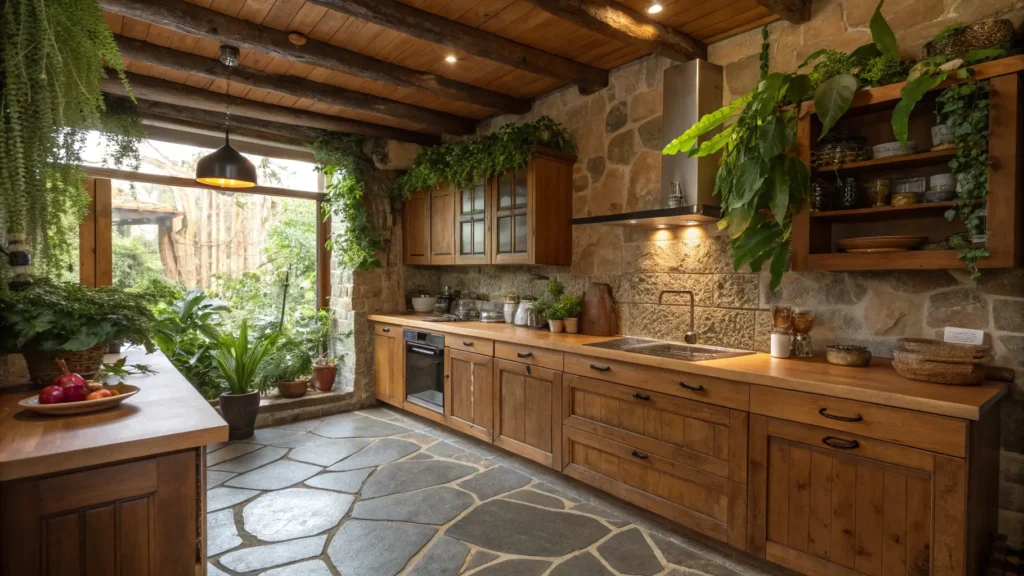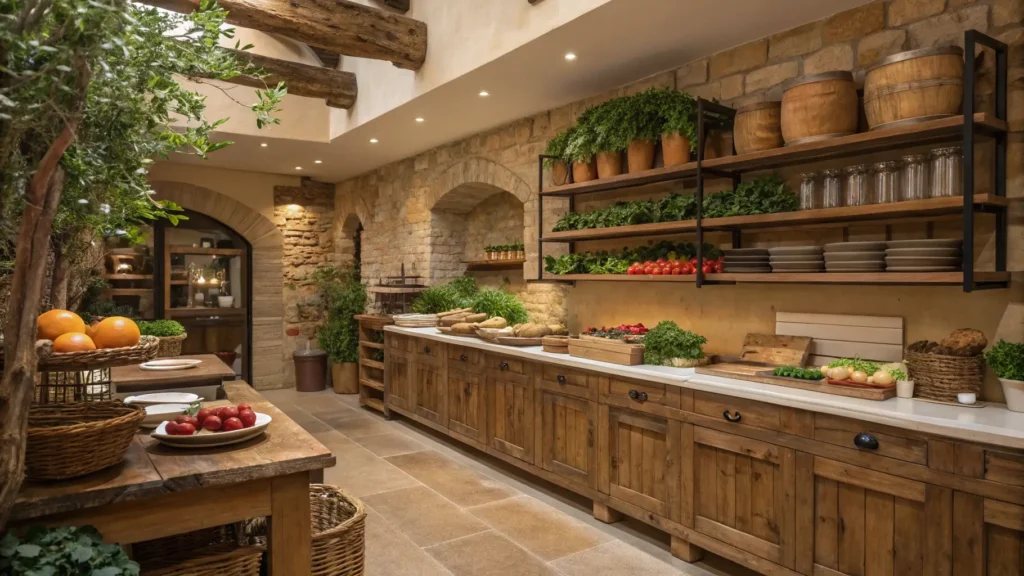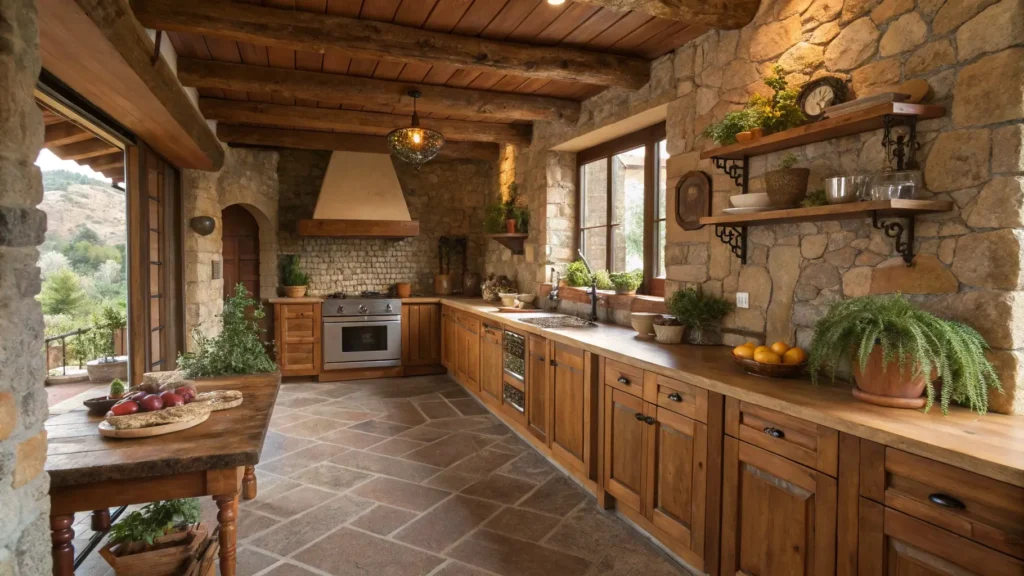I’ve always found myself drawn to kitchens that feel like a warm hug, spaces that ground you the moment you step inside. For me, an earthy kitchen isn’t just a room; it’s a sanctuary where natural elements blend to create a calming, inviting atmosphere. It’s the kind of space where I want to linger with a cup of tea, surrounded by the simple beauty of nature-inspired design. That’s why I’m excited to share my inspirations and tips to help you transform your kitchen into an earthy haven. If you’re dreaming of a kitchen that feels both stylish and soul-soothing, you’re in the right place.
TABLE OF CONTENTS
What Defines an Earthy Kitchen?
An earthy kitchen is characterized by its use of natural materials, warm and inviting colors, and a strong connection to the outdoors. It’s a space designed to evoke a sense of calm and well-being, moving away from stark, sterile environments. Think exposed wood, natural stone, handcrafted ceramics, and an abundance of plants. The goal is to create a kitchen that feels both functional and deeply grounded in nature.

Key Benefits of Embracing Earthy Kitchen Design
Embracing an earthy kitchen design offers numerous benefits, transforming your kitchen into the heart of your home. Here are a few key advantages:
- Creates a Relaxing Atmosphere: Natural materials and warm colors contribute to a calming and inviting space.
- Promotes Sustainability: Using eco-friendly materials and practices supports a healthier planet.
- Timeless Aesthetic: Earthy designs transcend trends, ensuring your kitchen remains stylish for years to come.
- Connects You to Nature: Bringing natural elements indoors fosters a sense of well-being and harmony.
Natural Materials: The Heart of an Earthy Kitchen
The foundation of any earthy kitchen lies in its use of natural materials. Sourcing these materials sustainably is crucial, minimizing environmental impact and supporting responsible forestry. Let’s explore some key materials:
- Wood: Reclaimed wood brings character and history, while bamboo offers a sustainable and stylish option. Oak provides durability, and maple adds warmth. Use wood for cabinets, countertops, and flooring. Look for Forest Stewardship Council (FSC) certification to ensure sustainable sourcing. Remember to regularly oil wooden countertops to keep them looking their best.
- Stone: Granite is durable and heat-resistant, while marble adds elegance but requires more maintenance. Slate offers a rustic feel, and soapstone is known for its smooth texture and heat retention. Sealing stone countertops is essential to prevent staining and damage.
- Clay & Ceramics: Terracotta tiles bring warmth and texture to floors and backsplashes. Handmade pottery adds a personal touch, and ceramic sinks offer durability and classic appeal.
Color Palettes & Textures: Creating Warmth and Depth
Color plays a vital role in creating an earthy ambiance. I recommend warm browns (#A6907C), muted greens (#8F9779), terracotta (#E07A5F), and creamy whites (#F5F5DC) to achieve that cozy, grounded feel. Balancing different textures is equally important. Combine rough wood with smooth stone, or matte ceramics with glossy tiles, to create visual interest and a tactile experience. A great example is pairing a reclaimed wood countertop with a smooth, ceramic tile backsplash. For additional ideas on creating a warm and inviting feel, consider this simple guide to Amazing Earthy Cottage Home Decor.

Lighting: Illuminating Your Earthy Haven
Lighting is key to setting the mood in your earthy kitchen. Maximize natural light by keeping windows clear and using light-colored window treatments. Supplement natural light with warm-toned artificial light to create a cozy atmosphere. Consider pendant lights with natural shades above the island, recessed lighting with warm LEDs for general illumination, and accent lighting to highlight specific features.
Plants & Natural Decor: Bringing the Outdoors In
Plants breathe life into an earthy kitchen. I love having fresh herbs readily available for cooking. Some plants that thrive indoors include:
- Herbs: Basil, mint, and rosemary are easy to grow and add fresh flavor to your meals.
- Snake Plants: Low-maintenance and excellent for air purification.
- Pothos: Trailing vines that add a touch of greenery to shelves or hanging baskets.
Place plants near windows for adequate light, and water them regularly. Other natural decor elements like wooden bowls, woven baskets, and natural fiber rugs enhance the earthy aesthetic. Consider using some of these ideas when planning your private backyard oasis.
Sustainable Practices for an Eco-Friendly Kitchen
Creating a sustainable kitchen involves choosing eco-friendly materials and adopting responsible practices. Look for appliances with Energy Star certifications, which indicates energy efficiency and long-term cost savings. Consider installing low-flow faucets and showerheads to conserve water. Reduce waste by composting food scraps and using reusable containers. I highly recommend investing in a set of bamboo utensils and cutting boards, since they’re durable and sustainable.
Earthy Kitchen on a Budget: Affordable Transformations
You don’t need a fortune to create an earthy kitchen. One of my favorite budget-friendly tips is to paint existing cabinets in a natural, muted color. Thrifting for vintage decor and repurposing old items can add character without breaking the bank. Building open shelving from reclaimed wood is another affordable DIY project.
Earthy Charm in Small Kitchens: Maximizing Space and Light
Earthy design works beautifully in small kitchens! Maximize natural light by using light colors on walls and cabinets. Choose space-saving appliances like a compact refrigerator or a built-in microwave. Incorporate vertical storage solutions, such as shelving or hanging organizers, to make the most of limited space.
Blending Styles: Earthy Elements in Modern Kitchens
Earthy elements can seamlessly blend with modern, minimalist, or other popular kitchen styles. Pair sleek, modern cabinets with a natural wood countertop or backsplash. Incorporate earthy textures through woven baskets or ceramic vases. The key is to maintain a cohesive look by balancing contrasting elements. For more ideas, explore our /decor category.
Technology in Harmony: Modern Amenities, Earthy Aesthetic
Technology can be tastefully integrated into an earthy kitchen. Conceal outlets with hidden charging stations. Choose appliances with a sleek design and stainless steel finish that complements the overall aesthetic. Use smart lighting systems to create ambiance and adjust lighting levels throughout the day.
Regional Variations: Earthy Kitchens Around the World
Earthy kitchen designs vary based on geographic location and available resources. Coastal kitchens often feature light colors, natural textures, and nautical elements. Mountain kitchens emphasize wood, stone, and warm, rustic details. Mediterranean kitchens incorporate vibrant colors, terracotta tiles, and olive wood accents. Scandinavian kitchens focus on simplicity, functionality, and natural light.
DIY Earthy Kitchen Projects: Hands-On Transformations
Get your hands dirty with these simple DIY earthy kitchen projects. Build a small herb garden by repurposing mason jars and creating a wooden utensil holder from reclaimed wood. Make beeswax food wraps as an eco-friendly alternative to plastic wrap.
Addressing Challenges: Overcoming Common Obstacles
Creating an earthy kitchen can present challenges. Finding sustainable materials may require some research and sourcing from local suppliers. Dealing with humidity and wood requires proper sealing and ventilation. Incorporating modern appliances seamlessly involves choosing models that blend with the overall aesthetic.

Frequently Asked Questions
How do I clean my wooden countertops? Use a mild soap and water solution, and always dry the surface thoroughly. Regularly oil the wood to maintain its moisture and prevent cracking.
Where can I find sustainable kitchen products? Look for eco-friendly brands online or at local retailers. Certifications like FSC and Energy Star can help you identify sustainable products.
What are the best plants for an earthy kitchen? Herbs like basil, mint, and rosemary thrive indoors, as well as low-maintenance options like snake plants and pothos.
Conclusion
Creating an earthy kitchen is an achievable and rewarding journey. By embracing natural materials, warm colors, and sustainable practices, you can transform your kitchen into a calming, inviting, and functional space. I hope these inspirations and tips have empowered you to create your own earthy haven.
I’d love to hear about your own experiences with earthy kitchen design! What are your favorite elements or DIY projects? Share your thoughts, questions, and photos in the comments below, and let’s continue this conversation together.
